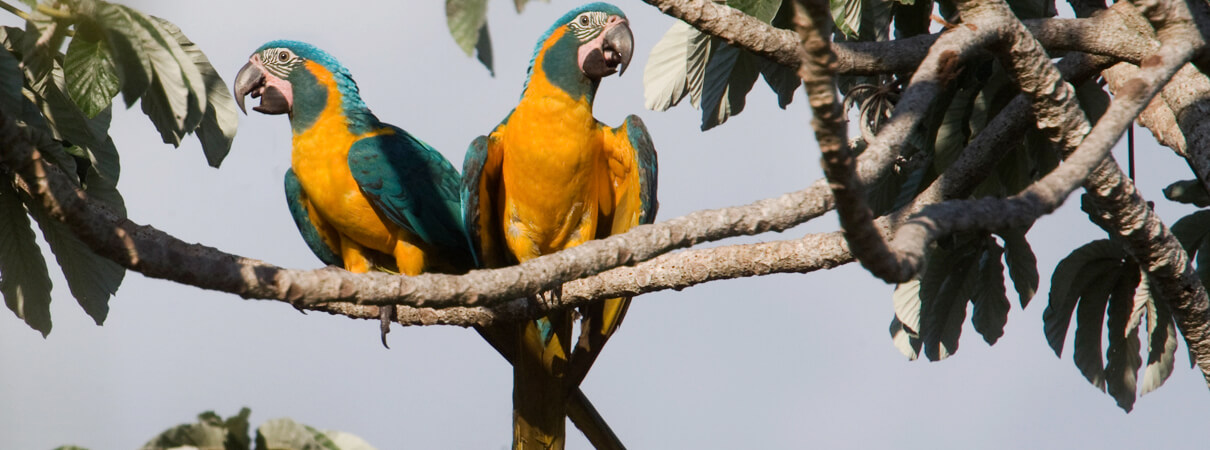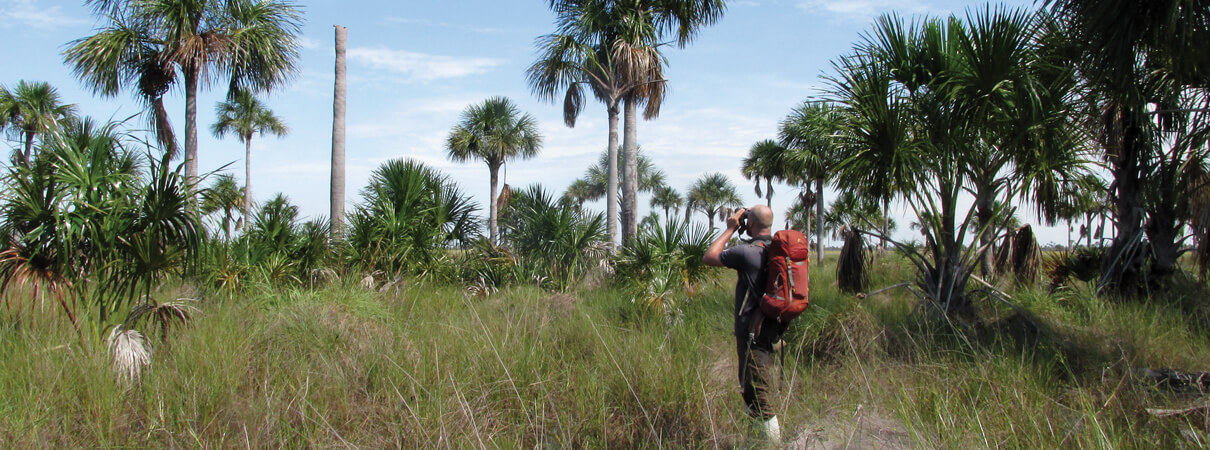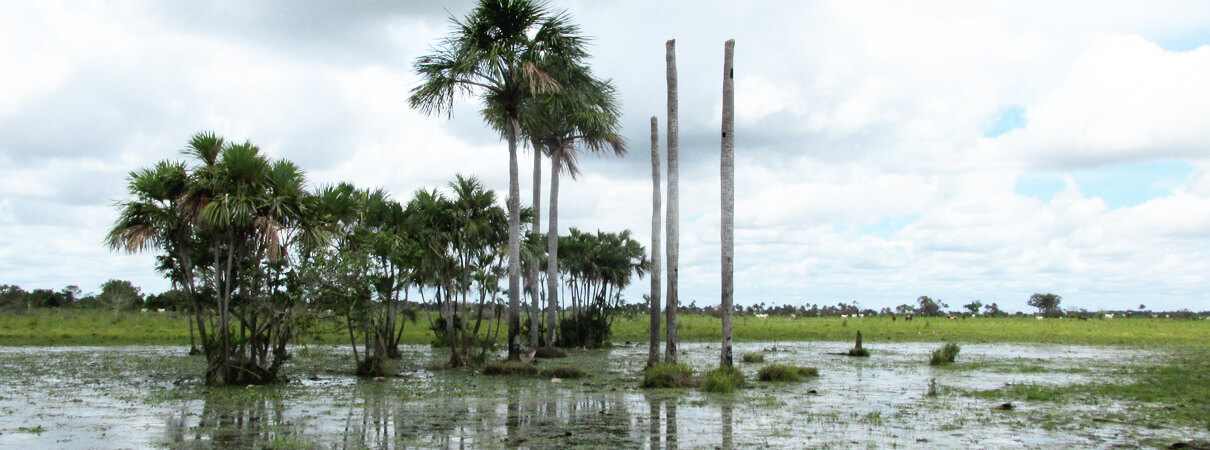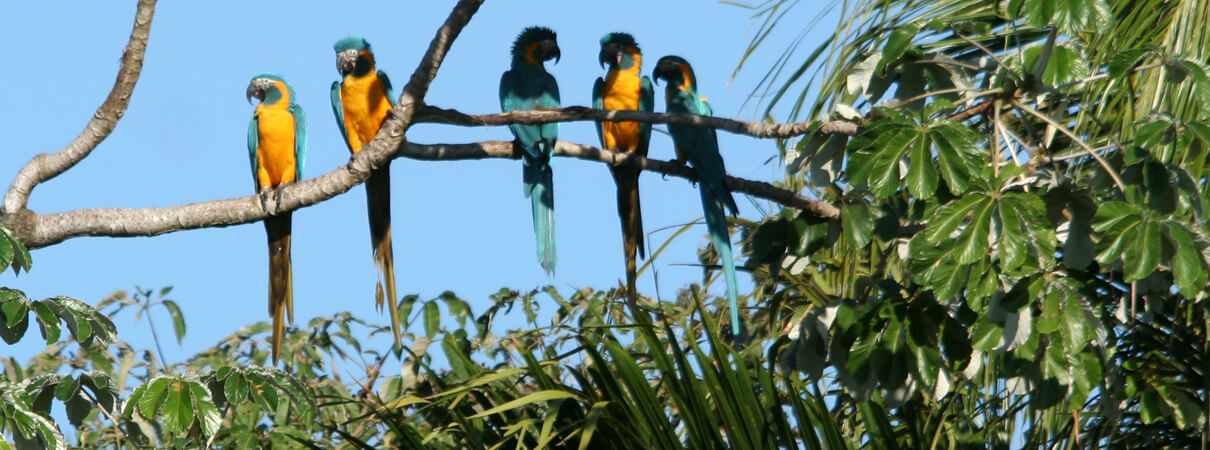Expedition Discovers New Breeding Area for Critically Endangered Blue-throated Macaw
For years, it was a question without an answer. Where do the majority of Bolivia's Critically Endangered Blue-throated Macaws breed?
This macaw is among the world's rarest parrot species. Only 250-300 individuals are believed to remain in the wild, the result of habitat loss, illegal collection for the pet and feather trades, and other threats. The International Union for the Conservation of Nature (IUCN) lists the species as Critically Endangered, meaning it is facing an extremely high risk of extinction in the wild.

Fewer than 300 of the Critically Endangered Blue-throated Macaw are believed to remain in the wild. Photo by Daniel Alarcon / Asociación Armonía
This makes the identification of the birds' breeding areas all the more important. If biologists can find the birds' nesting sites, they can work to help protect and restore the habitat that supports those birds.
Now, in an advancement for the conservation of the species, an expedition led by the Bolivian conservation organization and ABC partner, Asociación Armonía, has discovered a new nesting area for Blue-throated Macaws.
Flooded Savanna Harbors Hidden Populations
Armonía's successful 2017 expedition to find nesting Blue-throated Macaws actually got its first break in 2016, when 15 of the birds were discovered roosting north of the Barba Azul Nature Reserve. Here, ABC and other partners have supported Armonía's efforts to protect the birds' roosting and feeding grounds since 2008. That 2016 expedition was led by the reserve's Blue-throated Macaw Conservation Program Manager, Gustavo Sánchez Ávila, and supported by Loro Parque Foundation. Their 15-bird discovery provided the clue for where the 2017 expedition should start looking: north of the Barba Azul.
But this would not be an easy endeavor. Blue-throated Macaws nest during the region's rainy season, when the Beni savanna—the grassland habitat that covers the much of the area—is mostly flooded. Horses handle the flooded terrain better than cars. And so the 2017 Armonía expedition set out on horseback, led by Barba Azul Nature Reserve Coordinator Tjalle Boorsma.

To find the critically endangered Blue-throated Macaw, the expedition team set out on horseback across Bolivia's flooded Beni savanna. Photo courtesy Asociación Armonía
The trek was grueling, taking the team deep into the flooded grasslands north of the reserve. Initially they focused their searches on “forest islands” of motacú palm, which the Blue-throated Macaws will forage on year-round for their abundant fruit. But the expedition met with no success in these motacú-dominated stands.
“We registered a significant number of Blue-and-yellow Macaws in the area but, to our surprise, the motacú-dominated forest islands showed no signs of Blue-throated Macaws,” Boorsma said.

The Blue-throated Macaw expedition team pauses for a short break in the shade of some palms. Photo by Tjalle Boorsma
Then, approximately 70 miles north of the Barba Azul Nature Reserve, the team sighted a pair of Blue-throated Macaws flushing from a patch of royal palms. “The discovery gave a new scope to the whole expedition,” Boorsma said.
To confirm that the Blue-throated Macaws were indeed nesting there, Boorsma concealed himself in a makeshift palm blind. After six hours of patient waiting, he watched as the cautious Blue-throated Macaws return to their nest. A second nest was later discovered in another dead royal palm trunk.
The birds had nested in dry royal palm snags that were surrounded by flood waters, making the palms especially difficult to access. That natural barrier could very well be the reason why the macaws choose those particular palm snags for their nesting cavities.

Tjalle Boorsma uses binoculars to watch for nesting Blue-throated Macaws. Photo by Luis Miguel Ortega
Two more nests were later found in totaí palms at another location about 30 miles northwest of the reserve. In that case, the birds were nesting only about 150 feet away from a populated farm and showed no signs of disturbance from being in such close proximity to humans and livestock.

The 2017 Blue-throated Macaw expedition, led by Asociación Armonía and supported by ABC, discovered several pairs nesting in the hollow trunks of dead palm trees on the flooded Beni savanna. Photo by Tjalle Boorsma
“That was the missing piece we needed to complete our investigations,” Boorsma said. “Now we definitively know that Blue-throated Macaws prefer totaí and royal palms to nest in, as dead palm snags provide an excellent vantage point from which to observe their surroundings.”
Hope for the Blue-throated Macaw
Recent sightings of 118 Blue-throated Macaws at the Barba Azul Nature Reserve—a record high—indicate a healthy increase in the macaw population there, a sign that Armonía's conservation program is working.
However, most of these birds only use Barba Azul in the dry season, from May to November. They disperse to breed at the beginning of the rainy season, which runs from November to April, and return to the reserve in small groups starting in March.

Increasing numbers of Blue-throated Macaw at the Barba Azul Nature Reserve provide hope for the species' recovery. Photo by Benjamin Skolnik
It's too early to know for sure whether the macaws found during the 2016 and 2017 expeditions are the same birds that visit Barba Azul in the dry season or whether they belong to a separate population. To answer this and other questions about where the birds go, a group of experts led by an independent researcher, Lisa Davenport, is in the process of testing tracking devices suitable for this species, so that tagged birds can be traced during their seasonal migrations.
Learn more about the expedition here.
To add your support to our work to conserve the Blue-throated Macaw, please visit our donation page.
Editor's Note: We extend a special thank you to Patricia and David Davidson for funding this expedition and for their long-standing commitment to this project. ABC and Armonía are also grateful to the many other individuals, groups, and agencies that have generously given to the Barba Azul Nature Reserve and conservation efforts for the Blue-throated Macaw. They include George and Cathy Ledec, Warren and Cathy Cooke, Marybeth Sollins, Lucy Waletzky, Lynn and Stuart White, Jonathan Franzen, International Conservation Fund of Canada, IUCN National Committee of the Netherlands, Loro Parque Foundation, March Conservation Fund – Latin American Reserve Stewardship Initiative, U.S. Fish and Wildlife Service, The Robert W. Wilson Charitable Trust, World Land Trust, Weeden Foundation, Jeniam Foundation, and the Mohamed bin Zayed Species Conservation Fund.


















































